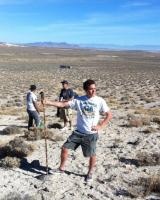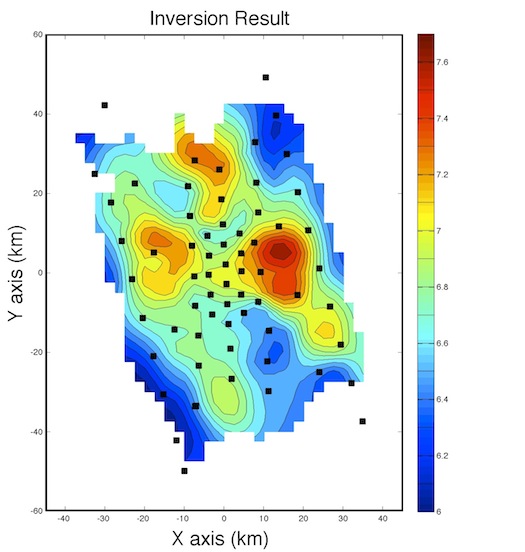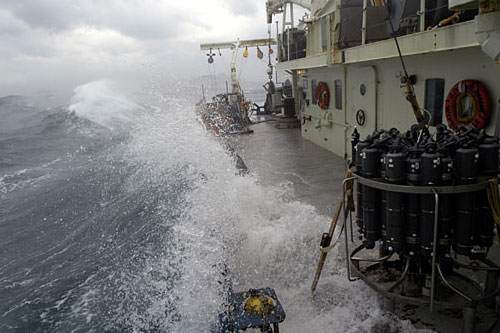Ryley Hill

Ryley Hill is a student at University of Nevada, Reno currently completing his research at University of Washington under Dr. William Wilcock .
Mid-ocean ridges are responsible for resurfacing 2/3 of the Earth’s surface and account for 80% of Earth’s volcanism. Seismic reflection surveys have been used to understand the melt lens beneath ridges for some time. However, seismic reflection surveys cannot image the lower crustal low velocity region. In my study we are using wide-angle seismology to model the area beneath the ridge axis. Making use of the seismic tomography data set collected on the Endeavour segment of the Juan de Fuca intermediate spreading rate ridge, I will be using a MATLAB based program titled tlPicker developed by my mentor, William Wilcock, to pick travel times for Moho reflections that cross the ridge axis in order to image crustal thickness and lower crustal velocities beneath the ridge axis. I will be extending a pick data set Moho reflection (PmP) travel times that currently do not include cross-axis paths. After inversion I will resolve the crustal thickness beneath the ridge axis and the extent of the the lower crustal low velocity zone and possibly propose further insight about the geology of the ridge from these findings. Also, I will be attending a ten day Cascadia Initiative cruise installing ocean-bottom seismometers (OBS) on the R/V Oceanus.
Week 9
August 7th, 2014
This week has been pretty hectic. I had written my AGU abstract, got it checked by my mentor, and submitted it, uncharacteristically, ahead of time. Things seemed really good until we took another look at my inversion result. William had a really keen eye in noticing that the bathymetry was off. We scratched our heads for a while and found that I was not inverting with the proper offset, but when that result came out it was even stranger. I worked with Dax to troubleshoot the issue- it was important to figure out the problem since my abstract was possibly based off an incorrect model. Just as the deadline was approaching we discovered the sneaky problem. While we were at sea the starting model was not present in the database so we needed to send it so I could work on it. However, the internet is very weak and the model is quite large so in order to transport it William wrote a nice bit of code to compress it. When we came back from sea I forgot all about the changes to the model. We figured out the problem, fixed it, and ran an inversion that produced a model that was free of any problems- basically the starting model was only slightly off because the data was ‘shrinked’ while we were at sea. With my new model we ran a forward problem to produce a synthetic PmP model to help me pick in areas that are difficult, and to refine my already existing picks. I will then be able to produce better inversion results all the way up to AGU.

The Cruise (Photos)
July 28th, 2014

TCD Machine and some waves.
Ocean Bottom Seismometers and Newport.
Leaving Eureka California
The Cruise
July 28th, 2014
It’s been a while blog, but I have been pretty busy this past week to really sit down and explain the cruise. I’ll try not to embellish the story too much, but it really was an amazing adventure for me with plenty of good and bad moments.
As we began our roughly six-hour drive down from Seattle to Newport I was noticing my throat was feeling sore. I tried to remain optimistic, but I could still tell I was getting sick. I chugged some Emergen-C and crossed my fingers, only to feel quite ill the morning before we set out to sea. I felt terrible, but I didn’t want to be that guy that didn’t help, so I managed to help load the ship while making some new friends among the scientists and crew. The crew was quite colorful, but more on them later.
We stayed the night on the ship, and the next morning as we set out on our voyage I encountered my first hurdle of the trip. Now I grew up in the fabulous desert of Las Vegas, and had only been on a recreational sailboat once in my life. Even then, I remember very specifically the terrible seasickness I experienced. However, I was older now and optimistic. My sister is in the Navy I thought, this should be easy. Within the first hour of eating breakfast I puked everything I ate and probably more. I would like to mention however, that the R/V Oceanus was designed in the 70s, and later refitted in the 90s with a deck house and pilot house- this increase in vertical weight adds to its roll as the ship travels. From what I was told, the ship on an average day does 30-degree rolls because of this added vertical weight, which is quite a lot, and can have some nasty effects for an inexperienced person like me. Sadly, I was pretty incapacitated for the first 50 hours. Being nauseous from seasickness and losing all of my fluids while I was sick took its toll. I stayed in my bed for the first two days, and only scurried to get breakfast once for some fluids. While I was eating breakfast a crewmember tried to make some small talk with me. I ended up telling him my sister was in the Navy when I noticed he had a Navy shirt on. He could definitely tell I wasn’t doing well, and kind of laughed and said, “Doesn’t run in the family I guess huh.. hahaha.”
Maybe my sister heard him, but by the next morning I was feeling totally better. I ate a ton of food, which, by the way, was absolutely amazing every day. My shift was 3pm to 3am, and I was finally able to join the other scientists. It was actually really fun. We helped monitor and setup the OBS (Ocean Bottom Seismometers) as another team deployed them. We also took some TCD (Temperature Conductivity Depth) tests between stations. I learned a lot, and was able to get some of my own work done for my project. We saw some dolphins, whales, and even caught some wild tuna that we ate the next day! Everything seemed to be going well, and we looked like we were going to come back to Newport early.. until the generator malfunctioned.
I remember sitting in the galley talking to my co-scientists when suddenly the abandon ship alarm went off and all the power went out. I quickly went to get my life jacket and lined up in my appropriate spot like we practiced in the safety drill. Of course this time everyone is scared enough to contribute to a worried atmosphere. We waited for a little while, and then the captain came down and told us there was nothing to be worried about, and that the problem should be fixed soon- definitely a sigh of relief was felt throughout the room. We got power back, and everything went back to normal- sort of. Within a few hours of the incident we had changed course. Instead of going to the next deployment site we were now heading toward the port in Eureka California for an emergency docking. Of course, this path brought us directly through a stormy area. No one really told me why and you don’t really ask questions when you’re in that situation, but you definitely don’t feel comfortable knowing whatever the issue is requires an ‘emergency docking’. My shift had me used to staying up to 3am, and I decided to stay up. I was hanging out in the galley when the chief engineer came in to grab some coffee. We had talked a little bit before about music and jazz, and he was a really nice guy. He looked a little tired and I asked him how everything was. With some added four letter words he made it clear things were not going well. He told me that they were not sure what the problem was, and had been up trying to figure it out for the longest time- something you always want to hear on your first cruise. While we’re talking, in walks one of my favorite members of the crew, Dave. If you have ever seen Jaws the boatman Quint played by Robert Shaw could probably be a close representation of Dave, yet probably Dave was harder to understand. Dave had this amazing phrase that he would use nearly everywhere he went... “Ohhhh yaaaa,” just like the Kool-Aid Man but add on 20+ years of habitual cigarette smoking. Anyway, he mentions to the engineer that it would be really bad if the power went out again. The stormy seas we were going through, if we had lost power again would leave us without being able to steer the ship into the waves and possibly a capsize. GREAT. I’m now kicking myself for being awake and hearing this. However, Dave probably noticed my face go white while hearing this and in an effort to console me talks about how even if that happened it wouldn’t be the worst he has seen and goes on to tell me stories of all the crazy things he has seen. For better or worse his stories chipped at the time and gave me some reassurance that it could be a lot worse. One of my fondest memories during those stories was when one of the veteran scientists came out of bed to grab some rope and straps.. I asked him, “What are those for?” and he just gave me a casual.. “Oh, to strap myself into the bed.” Just to paint a picture of how much we were rolling during that stormy night to Eureka.
We spent the following day in Eureka while the engineers worked to fix the problem. I had a much-needed call with my girlfriend and the scientists all went out to a nice Indian restaurant. We came back that night, and were so glad to hear that the problem had been solved- a loose circuit breaker. The next few days went by really smoothly, and we made it back in one piece. The cruise was definitely an adventure and it was an experience I will not soon forget. I really must tip my hat to the wonderful cook, scientist, and crew that worked so diligently to make it a successful trip. Will I do something like this again...probably not, but given the opportunity anything is possible.
Getting Closer to Inversion
June 24th, 2014
Currently I am starting inversion. I’m really excited to start putting all of the hard work and gruelling monotony of picking PmPs in the seismic data to use. The first few runs will be preliminary, and I will probably have to make some changes. However, after a few tweaks I’ll be able to produce a model I can work with. I might also find it necessary to make additional picks with more station/event combinations.
Since most of my time here has been making picks, there has been some challenges and success. The most challenging aspect has come from interpreting the seismic data when it gets very ‘noisy’. The geology of the mid-ocean ridge is quite complex so I get a lot of abnormal and sometimes hard to correlate results. Anytime I encounter something new and interesting William will help me find the PmPs, and that will usually help me correlate with the adjacent shot-lines. There has been a lot of success getting used to tlPicker though. I’ve managed to become very independent and quick in the program’s MATLAB menu and environment. Using the menu and tools I can quickly make the data easier to interpret, it’s just sometimes making it easy to look at still doesn’t make the complexity go away.
Week 3
June 20th, 2014
As I continue to pick PmPs on the seismic data I get ever closer to a finished product that I can use for inversion. I met with William and Dax, my mentor's graduate student, to discuss the gameplan for the next weeks ahead. I seem to be slightly ahead of schedule and should get to start on an inversion next week! I'm very excited to start on inversion. With inversion I will be able to model crustal thickness and get a better understanding of the areas at and near the ridge. While picking we have already encountered some interesting occourences that we can not explain very well. With the model we might be able to shed some light onto what we are seeing and address the important geological mysteries at hand.
Black IRIS in Seismic Data
June 13th, 2014
Currently I have been working with a data set collected through R/V Marcus G. Langseth. The ship conducted an experiment on the Endeavour segment of the Juan de Fuca Ridge where 68 four-component, ocean bottom seismometers were deployed at 64 sites near and away from the mid-ocean ridge. We are working with researchers from the University of Oregon. We had a conference call the other day, and I got a screenshot for the blog! I am currently picking points from different station/event combinations that cross the ridge axis. It’s tedious work, but luckily the world cup just started today so I will have a healthy distraction to not keep from going crazy. We use a program developed by my mentor called tlPicker through MATLAB to make the picks. It is not very fancy, but it gets the job done, and is effective in what we need to do. I haven’t started seeing seismic data in my sleep, but I have been seeing flowers by Georgia O’keefe.. Black IRIS (no pun intended, although quite conspicuous) ... doesn’t it look a lot alike?? I’m not going crazy right??



GOOOOAAAAALLLLL[s]
June 5th, 2014
Yes, the world cup is about to be in full swing, and while many goals will be scored in Brazil I have my own goals to score this summer...
1. Enhance my ability to navigate and use MATLAB and more specifically tlPicker. I will be picking a lot of PmP arrivals (estimated 30,000+). The faster I get at recognizing PmP arrivals and quicker at filtering the seismic refraction records the faster I will be able to get the bulk of my work done.
2. Enhancing my knowledge of the subject matter. I have a collection of six starting papers that will give me more insight into the lower crustal low velocity region and ocean ridges. I want to be able to enhance my reading comprehension of the area I’m studying, and be able to ask the BIG questions when I invert my data. (ie. map out the lower crustal thickness and lower velocity zones).
3. Conservatively, watch at least 90% of the World Cup. I have a dual-monitor setup and simply must take advantage of it. No seriously, a healthy work-life balance is important.
4. Gain Independence and Interdependence in a research environment. I want to develop the skills and knowledge to be able to work on my own for extended periods of time, but also not be afraid to ask questions to my mentor. I want to actually contribute ideas along side my work, not just information.
5. Experience Seattle. People have told me that this is the best time of the year to be living in Seattle.
Orientation!
May 29th, 2014
I have never seen so much free food in my life!
Much Learning Such Wow.



.JPG)
.JPG)